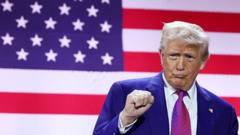China is experiencing a trade renaissance, reshaping global economics as tariffs push its exports into new markets.
China's Export Surge: A New Shockwave for Global Trade

China's Export Surge: A New Shockwave for Global Trade
As President Trump's tariffs limit access to the U.S. market, Chinese goods are rapidly filling demand in Southeast Asia, Europe, and Latin America.
In a striking turnaround, Chinese exports are making waves across the globe as trade tensions between China and the U.S. escalate. With President Trump's tariffs drawing tighter around Chinese goods, the country is redirecting its shipments to markets worldwide, from Southeast Asia to Europe and Latin America. This shift is reminiscent of the early 2000s when China's manufacturing prowess first stunned the U.S. economy.
So far this year, China's trade surplus has surged to nearly $500 billion, representing an unprecedented 40% increase compared to the same timeframe last year. As these developments unfold, economies around the world brace for significant adjustments. "China has an excess of products that need international markets, and the United States can't halt the reorientation of these exports," noted Leah Fahy, a China specialist from Capital Economics.
Moreover, China's production capabilities are expanding rapidly. The country has reported a 45% increase in electric vehicle assembly lines compared to last year, indicating a vigorous pivot toward innovation and technology-driven exports. This proactive adaptation to the trade environment illustrates the resilience and determination of Chinese manufacturers to maintain their global presence despite the challenges posed by U.S. tariffs.
As the geopolitical landscape shifts, global consumers can expect an influx of Chinese products flooding various markets. The repercussions of this new export wave will not only redefine international trade dynamics but also have lasting effects on economies worldwide. The world now stands on the brink of a significant China shock, with nations striving to navigate the evolving links between trade policies and market accessibility.





















